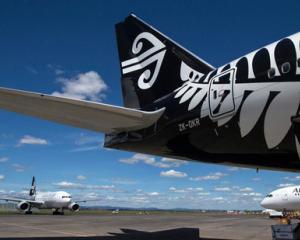Engineers have found no evidence of a bird strike or engine damage after an Air New Zealand Boeing 767 caused a full scale emergency when it landed on one engine in Auckland yesterday.
The aircraft had just taken off from Auckland for Perth yesterday with 206 passengers and 10 crew on board when the pilot told air traffic controllers there was a problem with the port engine.
The aircraft turned around and landed safely on one engine about 2.40pm after sparking a full-scale emergency turnout of airport fire appliances.
It had been suggested the aircraft hit birds which caused the engine to flare up but the airline said an inspection revealed no evidence of a bird strike and no engine damage.
The airline said the pilot throttled back from takeoff thrust as normal when the aircraft became airborne.
"But at this time there was an interruption to the airflow through the left hand engine which caused the flare seen from the rear of the engine," said an airline spokesperson.
The pilots reducing thrust on engine and it began operating normally.
"Regardless of the engine returning to normal operating levels, the pilots followed Air New Zealand's conservative operating procedures and undertook a precautionary engine shut down before returning to the airport so the cause of the airflow disruption could be determined," the spokesperson said.
Airline general manager operations and safety Dave Morgan said the change in the airflow in the engine created a similar reaction to a car backfiring.
"The investigation has established no evidence of bird strike as a cause for the disruption to airflow and no damage to the engine itself."
The unit responsible for the control of airflow through the engine had been removed and replaced, and would be sent to the manufacturer for testing.
Passengers said it was very scary to see flames come from the engine and hear loud bangs soon after they took off.
They said the aircraft lurched before a nervous flight attendant told them something had gone wrong and they were heading back to Auckland.
Passengers were taken to hotels last night before flying out on another aircraft at 1am today.
Earlier, an experienced pilot said the passengers on the flight were never in danger.
Stuart Julian, technical director of the Airline Pilots' Association and a 767 pilot, said the twin-engined Air New Zealand Boeing 767-300 was designed to take off and land on one engine.
Mr Julian said any modern jet was designed to take off and land with one engine out of action.
"Pilots train to fly with one engine not working."
There would be some drop in the performance of the aircraft if one engine failed, he said.
"But even with that smaller amount of performance with just one engine, that is enough to cover all the safety margins."
He said every takeoff included a plan for an engine failure and every six months a pilot would practise an engine failure.
"It is not a big deal for us. It is what we train for and what we practise," he said.




